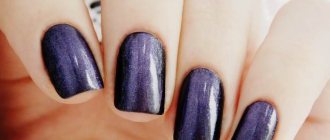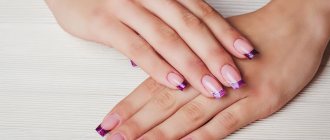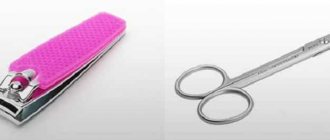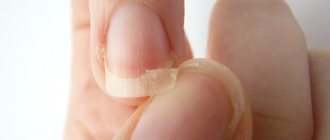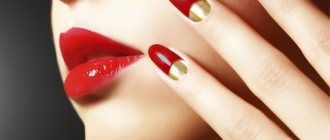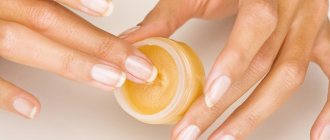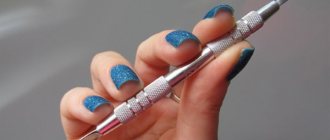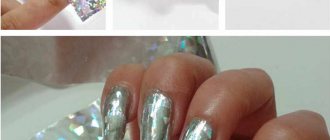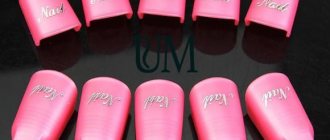A magic wand really does exist, at least in manicure. This is a buff, as everyone affectionately calls it, it is vital if you want to have beautiful, well-groomed hands. A good manicure without a buff is simply impossible; this universal file performs many functions in manicure for natural and extended nails. The right buff and using it according to all the rules will prepare your nails for any luxurious coating. Why do you need a nail buffer, why is it so good, and why should it be in any fashionista’s manicure set? Let’s find out right now.
Using the buff
Advantages of a unique nail file
The secret of the buff is that it is usually a block, each edge of which performs a specific task, and this depends on the different abrasiveness of the edges.
What is each edge needed for?
- the first side is a regular file to create the desired shape of nails, they can be shortened and trimmed;
- the second side is used to remove irregularities on the plate - burrs, roughness;
- a third party sands and removes minor imperfections;
- the fourth side polishes the plates, giving them a natural shine.
Using buffs
So, we figured out what a buff is. It remains to understand how to use it. It is worth remembering that you cannot resort to it often.
The wide side of the buff is applied to the nail, covering it as much as possible. The movements should be long, the tool should handle the same area as little as possible. It is very easy for an inexperienced person to damage a nail. When filing and polishing a nail, the movements cannot be changed. The buff can only be moved in two directions: right and left. To avoid the risk of damage to the nail plate, polishing your nails should be done no more than once a week, so as not to worsen their condition.
Use various strengthening products such as cuticle oils after application. This will strengthen the nail and seal the cuticle. If the buff is used incorrectly, it can lead to deformation of the top layer of the nail plate, and, accordingly, to pain. That is why it is worth remembering the rules for using the buff and not ignoring them.
Let's look at the main characteristics of buffs
What materials can buffs be made from?
The base is usually made of plastic, wood, silk and other fabrics.
Working surfaces can be:
- polyethylene foam (plastic) - popular, cheap, durable. They can be sterilized;
- silicone can also be washed and disinfected, durable, inexpensive;
- The suede buff may have handles, the quality is average, it is impossible to disinfect;
- a fabric buff is of good quality, suitable for natural nails, elastic, but the cost is higher, especially for a silk-coated buff, and cannot be sterilized.
Caring for manicure buffs
A polisher purchased for home or salon use must be disinfected. There is an opinion that only metal objects are sterilized. However, this is not true; you can clean the file using an antiseptic spray. This method of surface treatment is used by an expert from our magazine.
Place the sander at a 45 degree angle and start spraying the alcohol solution from top to bottom. The product seems to wash away the nail material from the surface of the instrument. You will be surprised, but the method really works. Traces of saw cuts are washed off the block. Afterwards you need to let the surface dry and the buff can be used again.
How to use it correctly
If the buff is used incorrectly, the nail plate may become deformed and pain may appear, so you must adhere to the rules.
Using the buff
We provide step-by-step instructions on how to use a nail buff when preparing for a manicure:
- apply a buffer to the nail so as to cover the entire surface of the nail plate;
- It is advisable to make a minimum of clicks;
- carefully, in the same direction, make long movements, trying not to stop in the same place;
- you cannot change the direction of movement;
- You cannot constantly use a buff; polishing must be done once a week, otherwise the nail plate will weaken and become fragile;
- The final procedure after polishing is sealing the nails. To do this, add one drop of tea tree oil and spread it over the entire surface of the edge, rubbing lightly. This will prevent your nails from peeling and make them strong;
- The instrument is reusable and requires care and disinfection.
Video
Basic rules of use
The purpose of the tool explains the specifics of how to use a nail buff. They need to work according to the following rules:
- Apply the side of this file to the plate with a wide edge, trying to process a large area at a time.
- There shouldn't be a lot of fast movements.
- The direction of movement should be one-sided: from base to tip.
- It should be used no more than once every 7-10 days, since constant polishing with a buff can noticeably thin the plate and make it brittle.
- To prevent lamination, you can use this polishing tool as a material for applying essential oil. It is enough to drop a small drop of tea tree oil onto the plate and spread it as a buffer over the surface, thereby sealing the nail.
These rules allow you to understand how to buff a nail correctly. Following them will help keep your manicure in perfect condition so that your nails remain healthy and well-groomed.
All about abrasiveness
The different functionality of the edges is explained by different degrees of abrasiveness, that is, the size of the grains (pores) on the surface of the buff. Abrasiveness determines the hardness of each edge and is measured in grits. Let's consider the classification of abrasiveness and the functionality of the edges:
- 60-80 gr. These are hard buffs for rough polishing of extended and artificial nails and performing pedicures;
- 100-150 gr. Suitable for correcting extended nails before applying gel polish; you can correct fingernails and toenails extended with acrylic or gel plates;
- 150-240 gr. You can file down natural and artificial nails, file the tips of natural nails, polish artificial nails;
- 300-450 gr. This is a buff for natural nails, for delicate work with them. The grain size is fine, soft polishing of the surface of natural plates is possible.
Mini nail buffs
Important. Which buff to choose depends on the purpose of the tool. For thin and weakened nails, a buff with maximum abrasiveness is suitable - above 300 g. The best material is suede, which acts gently and is gentle on nails.
Which buff is better to polish nails: abrasiveness
We have already found out that a buff is also a file, but there are significant differences. The peculiarity of polishing blocks is that they are made of softer materials and are more delicate. Specific devices are classified based on the material from which they are made (fabric, glass, plastic, etc.), as well as abrasiveness. Abrasiveness is a criterion that determines the number of grits, that is, “pores” on the surface of the bar.
The abrasiveness determines what the tool will be used for, as well as what type of nails it is intended for.
Depending on the purpose, the following types of buffs are distinguished:
- abrasiveness from 60 to 80 grit. Bars of this type are used for working with artificial nails or for pedicures. These buffs are distinguished by a high degree of rigidity and roughness;
- abrasiveness from 100 to 150 grit. Used to correct extended nails, for example, before gel polish. This roughness indicator allows for high-quality polishing with the removal of all irregularities. Files with a similar indicator are also successfully used to polish the surface of toenails;
- abrasiveness 150 – 240 grit. Used for working with artificial nails or cutting your own nails;
- abrasiveness of 300 and above allows the files to be used when working with natural nails. The use of the tool makes it possible to qualitatively polish the nail plate to a shine.
Instrument care
Gradually, dirt and bacteria may accumulate in the bar, so it must be sterilized after each use.
Nail buffs
It is better to choose a tool with easy maintenance:
- fabric products allow water to pass through, so they are simply replaced with new ones, but can be cleaned with a brush soaked in a disinfectant;
- plastic buffs are easy to disinfect and can be washed in a warm soapy solution;
- The ideal option is to purchase several bars with different abrasiveness, from different materials and change as needed; this is an option for those who do not have to save.
Using a four-way buff
What is a nail polishing buff?
Buffs act on the nail plate according to the same principle as nail files, so they are used as a professional tool for manicure. The main difference between a buff and a nail file is the fine grain, which makes it multifunctional. What is the buff for? The tool is great for caring for false and natural nails. At home, the block is used comprehensively: for polishing, grinding, and shaping nail plates.
- Broccoli casserole: step-by-step recipes for cooking at home with photos
- Antibodies to thyroid peroxidase
- Hungarian goulash - how to prepare a classic dish at home using step-by-step recipes with photos
Types of nail files
The buff polishing file is made from different materials. The basis is fabric, plastic or wood, the working surface is made of suede or silicone, and the grain size is created in several varieties. As a rule, a nail buff is a voluminous four-sided bar with numbered sides. Numbering is used so that during a manicure you know which function needs to be applied.
- The first side is to give the nail the desired shape.
- The second edge removes unevenness of the nail plate.
- The third side is the grinding side, which smooths out imperfections.
- The fourth side is the final polishing of natural or gel (acrylic) nails to a shine.
Abrasiveness
For polishing natural nails and extending them, a buff is better suited than a file, as it has greater functionality. The advantage of a polisher is its varying abrasiveness, which determines what the tool will be used for. There are several indicators indicating the number of pores (grits) on the surface of the bar:
- The abrasiveness of the files 60-80 grit means that the tool is excellent at polishing acrylic nails, because the surface of the buff in this case is rough and hard.
- Bars marked 100-150 grit are ideal for treating toenail plates and before applying gel polish. This abrasiveness effectively removes all unevenness.
- The abrasiveness of the grinding tool 150-240 grit means that it is advisable to use it for filing the ends of natural or polishing artificial nail plates.
- Markings 300 grit and above are the smallest and softest. These bars are used for final polishing.
Alternative
Buff is not sold on every shelf in every store, however, it is better to find and purchase it, since there is simply nothing to replace it. A buff and a nail file differ in the quality of processing; a simple file has a rather low quality. If, nevertheless, there is an urgent need for a manicure, but there is no buff, the solution is as follows:
- any file with an abrasiveness of more than 300 gr. can help out temporarily;
- polishing, elimination of defects and irregularities can be done with any rough material, for example a piece of rough, harsh fabric.
Nail file buff
Results. A good quality buff will help to thoroughly polish your nails for gel polish coating; it will lie firmly on the nail. The life of the gel polish will be significantly extended, but you need to take into account the condition of the nail plates - if they are thin, you need to choose a softer buff.
How to polish your nails with buff
A buff for polishing nails is used almost in the same way as a regular file, but it has its own nuances. In order not to harm the nail plate and achieve the desired results, use the buff correctly:
- Apply the working surface of the grinder to the nail plate with the wide side to cover the largest possible surface.
- During processing, make as few movements as possible.
- The nail polishing file is not intended to be used every day, so it is advisable to use it no more than once a week.
- After polishing, professionals advise to “seal” the nails so that they do not peel off. To do this, drop any essential oil onto the nail plate, then work with the softest side of the sander.
- Road tax for pensioners in Moscow - procedure for applying for benefits and necessary documents
- 9 Foods That Cause Food Poisoning
- What payments are due to pre-retirees?
What are buffs?
The operating principle of this tool is practically no different from a regular file. The only major difference is the finer grain size. An inconspicuous bar at first glance does an excellent job of its functions and can easily replace some professional procedures. The tool is ideal for the care of natural and artificial nails and is very convenient for home use. Today, several types of buffs are produced. They are usually made on fabric, plastic and wood bases. The working surface itself is made of suede, silicone and other materials.
How to use a buff correctly?
The buff is used to remove unevenness from the nail and prepare it for the application of modeling gel or regular polish. After all, good polishing is the key to a high-quality and beautiful manicure.
All buffs are divided among themselves by abrasiveness, that is, by the number of “pores” on its surface. To work with a natural nail, it is better to choose one with a large number of grits (pores). If you have thin nails and just need to give them shine, then choose at least 500. If you decide to get a pedicure, then it is better to take an abrasiveness of 60-80 grit. They're pretty rude about it. It can also be used for artificial nails.
Buffs are also good for “sealing” nails. If they constantly flake, you can drop a little essential oil on them and rub with the softest side. This procedure should be done every week.
It is necessary to apply the buffer to the nail with the largest side so that it covers as much area of the nail as possible. In order not to damage the nail plate, there is no need to work too hard, a few movements are enough.
Try not to change the direction of the cut. Movements should be made from side to side.

